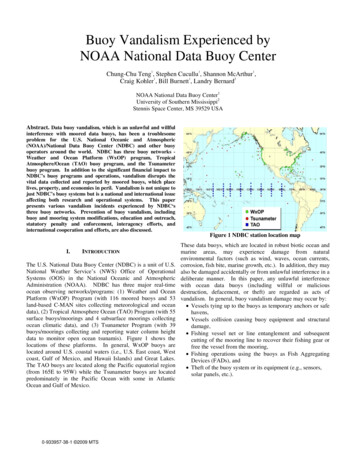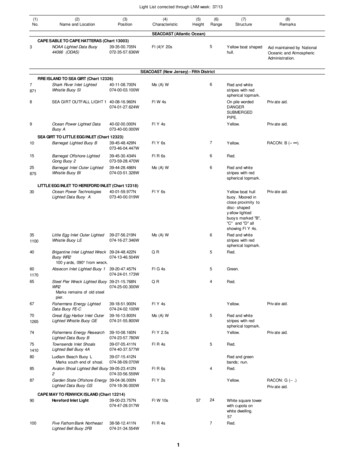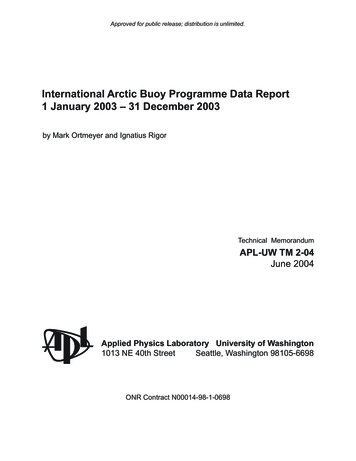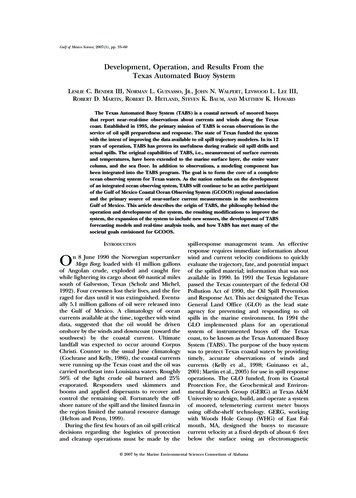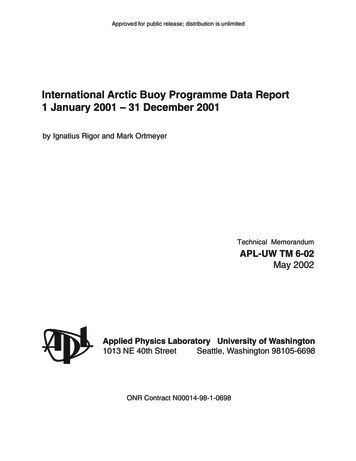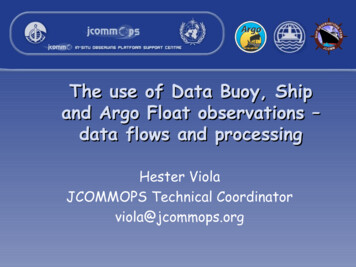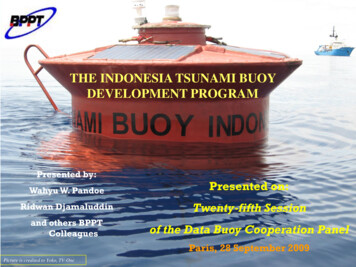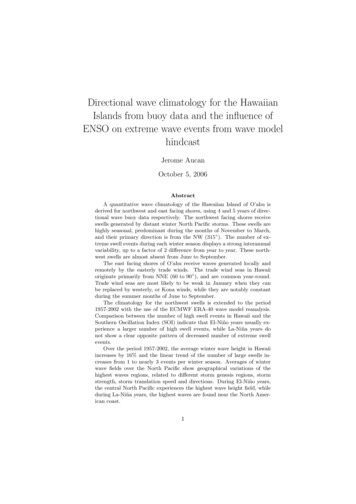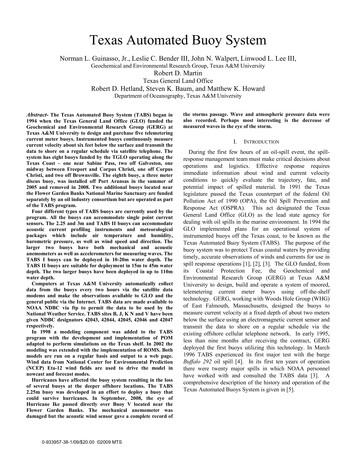
Transcription
Buoy VandalismData Buoy Cooperation PanelScience and Technology Workshop28 September, 2009Paris, FranceChung-Chu Teng, Stephen Cucullu, ShannonMcArthur, Craig Kohler, Bill Burnett and LandryBernardNational Data Buoy Centerbill.burnett@noaa.govNWS – National Weather Service
Three Major Networks Weather/Ocean Platform (WxOP) Network– 114 Moored (Met/Ocean) Buoys – including 12Hurricane Supplemental Buoys.– 52 land-based Coastal–Marine Automated NetworkStations (C-MAN) Tropical Atmosphere Ocean (TAO) BuoyNetwork– 55 TAO Buoys 4 ADCP Moorings Tsunameter Buoy Network– 39 DART BuoysNWS – National Weather Service
NDBC Ocean Observing System ofSystems (NOOSS)NWS – National Weather Service
Buoy Vandalism Any unlawful interference with oceandata buoys (including willful or maliciousdestruction, defacement, or theft) isregarded as acts of vandalism. Impacts:– significant financial impact to NDBC’s buoyoperations– disrupting the vital data collected andreported by the buoy systems, which placelives, property, and economies in perilNWS – National Weather Service
Vandalism Damage Vessels tying up to the buoys astemporary anchors or safe havens, Vessels collision causing buoy equipmentand structural damage, Fishing vessel net or line entanglementand subsequent cutting of the mooringline to recover their fishing gear or freethe vessel from the mooring, Fishing operations using the buoys asFish Aggregating Devices (FADs), and Theft of the buoy system or its equipment(e.g., sensors, solar panels, etc.).NWS – National Weather Service
Vandalism on Weather andOcean BuoysIn FY08 – Out of a total of 19 mooring failures, 8 wereattributed to vandalism Three (3) of the 6 structure damages werelikely result of collision or pulling on superstructure Out of 11 failures due to electrical componentdamage, 3 were likely or confirmed results ofvandalism Two of the 24 failures due to critical sensordamage were confirmed as a result ofvandalismNWS – National Weather Service
Vandalism on Weather and OceanBuoysNDBC WxOP buoy vandalism: long-lineNWS – National Weather Service
Vandalism on Weather and OceanBuoysNDBC WxOP buoy vandalism: theftNWS – National Weather Service
Vandalism on TAO Buoys Between October 2007 and June 2008, eighteen (18)TAO buoys in the Tropical Pacific Ocean went offstation due to vandalism A recent case of buoy theft occurred at an NDBCTAO buoy resulting in the total loss of the asset.– On May 1, 2009, the TAO mooring located at 8oN 95oWshowed signs of vandalism evidenced– By the next day it became obvious that the equipment wason a ship as it was traveling at a high rate of speed.– It made landfall at Puntarenas, Costa Rica on May 14, 2009shortly after midnight GMT.– On May 15, the Costa Rican Coast Guard searched the areafor the missing equipment, but was unsuccessful.NWS – National Weather Service
Vandalism on TAO BuoysTAO buoy hull damage due to vessel collisionNWS – National Weather Service
Vandalism on TAO BuoysTAO buoy superstructure damage due to vessel collisionNWS – National Weather Service
Vandalism on TAO BuoysTAO buoy vandalism: long-lineNWS – National Weather Service
Vandalism on TAO BuoysTAO vandalism – fishing activity (possible sling shot)NWS – National Weather Service
“Sling shot” Method a fishing vessel ties to the buoy; the vessel moves away and stretchesthe mooring; the vessel releases the buoy; the buoy settles back over the anchorwhile the buoy is returning to theoriginal position; and the vessel sets nets to catch the fishfollowing the buoys.NWS – National Weather Service
Vandalism on Tsunameter Buoys NDBC completed the 39-buoy network inMarch of 2008 Among the fourteen adrift buoys, threetsunameter buoys’ mooring lines were cut. In some adrift cases, although NDBCcategorizes them as unknown, it is likely thatsome of them were due to vandalism. The total cost for replacement of atsunameter buoy is up to 375,000 (includingequipment, labor, and ship time).NWS – National Weather Service
Vandalism on Tsunameter BuoysTsunameter buoy vandalism: mooring line cutNWS – National Weather Service
Vandalism on Tsunameter BuoysTsunameter buoy vandalism: structure damageNWS – National Weather Service
Prevention of Buoy Vandalism:Buoy and Mooring Design and Buoy Location Using different buoy or mooring designs to reduce orprevent buoy vandalism.– more robust mooring systems (e.g., using abrasion or cutresistant mooring components),– shorten or eliminate superstructures,– protect or hide critical equipment (e.g., transmitter, antenna,etc.),– make a buoy difficult to “board”, and make equipment difficult toremove, etc. However, there is only so much buoy operators can dowith technology without drastically increasing operatingcosts, making a buoy system more difficult to operateand maintain, or adversely affecting data quality. NDBC will continue to investigate the prospect ofdisestablishing or moving buoys from problematiclocations.NWS – National Weather Service
Prevention of Buoy Vandalism:Education, Outreach, and Working Groups So far, most of the efforts to prevent data buoyvandalism have been mainly limited to educationand outreach. Education and outreach have limited impact onthe overall problem. However, education and outreach efforts have tobe sustained over a long period of time canproduce positive results. NOAA plans to establish interagency workinggroups to investigate a data buoy vandalismalleviation strategy.NWS – National Weather Service
Prevention of Buoy Vandalism:Statutory Penalty and Enforcement It will be more effective through statutory penalty andenforcement to curtail buoy vandalism. In U.S.– Title 33 of the Unites States Code (USC) contains two statutesthat can be used to prevent data buoy vandalism and accidentaldamage (i.e., 33 USC § 408 and § 412).– Several Parts under Title 33 of Code of Federal Regulations(CFR) contain regulations aimed at protecting aids to navigation,which could be amended to include data buoys.– Many coastal and Great Lakes states have statutes that could beused to address data buoy vandalism in state waters.– NDBC has initiated and continues to pursue coastal buoys beingclassified as Aids to Navigation (ATON), which would haveadditional regulatory, statutory and subsequent enforcementbenefits.NWS – National Weather Service
Prevention of Buoy Vandalism:International efforts DBCP has been working with the WMO-IOC participants for years tohighlight buoy vandalism problems. This year, the DBCP will draft a letter for the WMO-IOC that detailsspecific issues and presents possible solutions to buoy vandalism. NOAA recently submitted a draft resolution on data buoy vandalismto the IOC, which– calls for action to the UN General Assembly in order to preserve theintegrity of monitoring systems that are so essential to preserving lifeand property in coastal communities around the world.– calls upon [UN] Member States to take appropriate steps under theirnational law to prohibit damage of or interference with ocean and coastal observingsystems, institute incentives to reward those who supply information that supportsenforcement of such prohibitions, develop procedures to facilitate retrieval of non-functioning ocean andcoastal observing systems, and educate local communities.NWS – National Weather Service
Thank youWilliam H. BurnettNOAA National Weather ServiceNational Data Buoy AA.GOVNWS – National Weather Service
NWS -National Weather Service Buoy Vandalism Data Buoy Cooperation Panel Science and Technology Workshop 28 September, 2009 Paris, France . National Data Buoy Center 228-688-4766 Bill.Burnett@noaa.gov WWW.NDBC.NOAA.GOV Thank you. Title: PowerPoint Presentation Author: NDBC Created Date:
